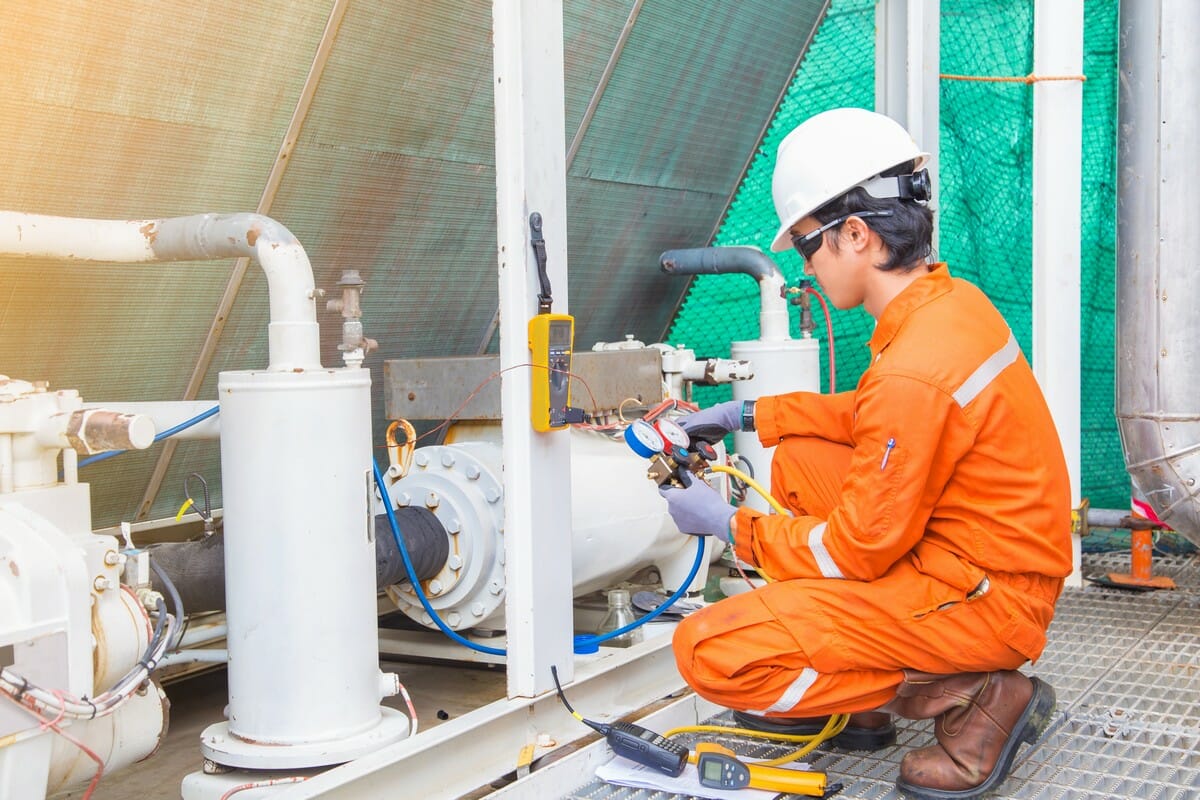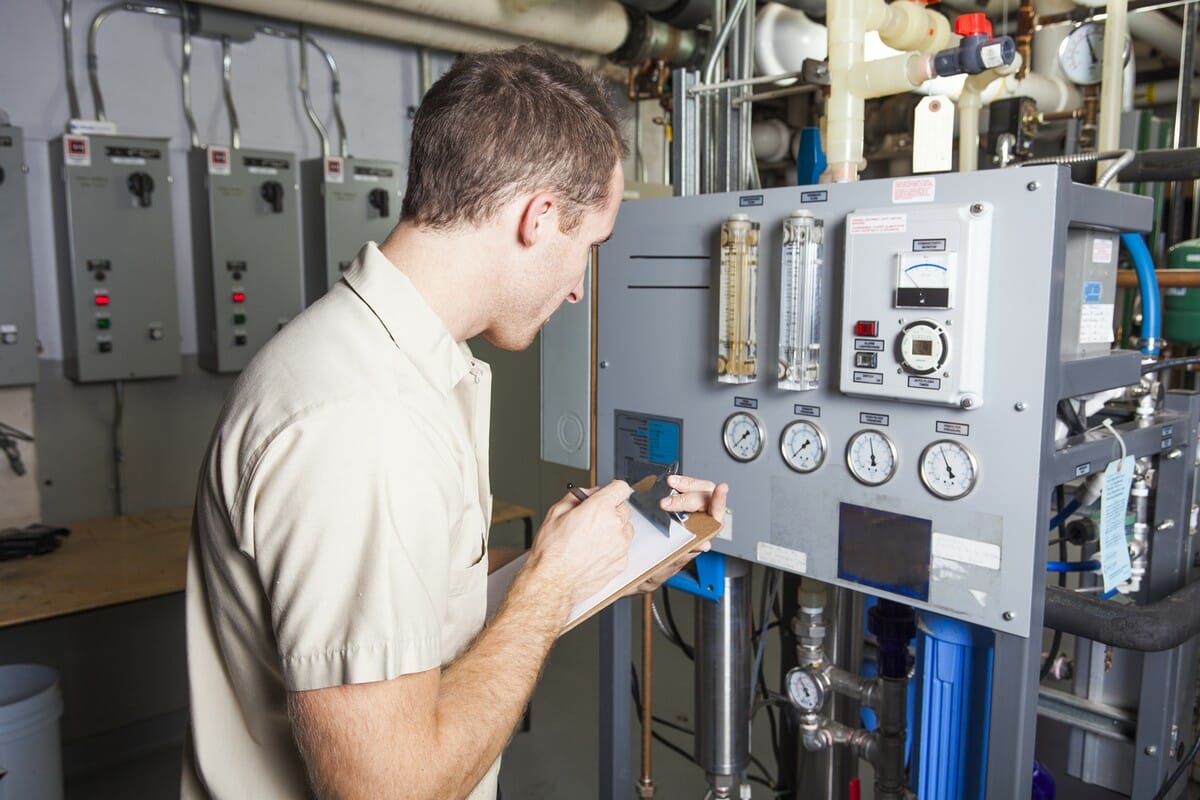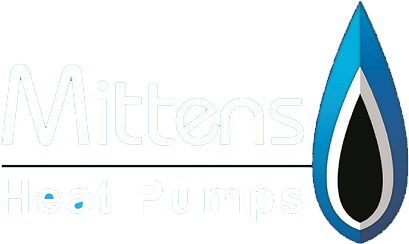Refrigerant and Working Fluids
Table of Contents
- 1 - Refrigerant Types in a Heat Pump
- 2 - What is a Refrigerant and how Does it Work?
- 3 - Modern Refrigerant Types vs. CFCs
- 4 - Using Carbon Dioxide as Refrigerant
- 5 - When Would you want to use Something Other than CO2?
- 6 - Common HFCs and Their Benefits
- 7 - Water and Antifreeze – Brine
- 8 - Can you use Natural Gases as a Refrigerant?
Refrigerant Types in a Heat Pump
Heat pumps are excellent systems for heating and cooling. The way a heat pump does both of its jobs is through a refrigerant (a chemical compound). Refrigerants are fluids that both absorb heat and produce heat in heat pump systems. A heat pump’s efficiency depends on the choice of refrigerant. There are a number of refrigerants available for use in mechanical heat pumps – both natural and synthetic.

Investment costs, installation size required, safety, and permits must all be taken into account when determining what refrigerant to use in heat pumps.
What is a Refrigerant and how Does it Work?
A refrigerant is a chemical mixture that can quickly change form from liquid to gas.
There are different types of refrigerant mixtures, but R-410A is the most common type used in modern heat pumps and air conditioners. R-410A does not cause ozone depletion and it is designed to replace R-22, which is expected to be fully phased out by the end of 2020.
A refrigerant is very effective at heat exchange because it can quickly change between a gaseous and liquid state. This is the movement of heat from one location to another. You should know that refrigerants don’t create heat or cold, they merely transfer them. A refrigerant absorbs thermal energy from the air as refrigerant evaporates inside, making the room feel colder. It then releases the heat by condensation elsewhere. In heat pumps, the process is also reversed.
Our Guarantee
- Over Six Years Experience
- Unrivaled Experience
- An Exceptional Service
- Unbeatable Value For Money
- Industry-approved Scaffolders
- A Full Range of Heat Pumps Services
- Professional, Reliable and Diligent
- 100% Safety and Satisfaction
The Heat Pump and Refrigerant
Heat pumps and air conditioners use refrigerants in the same way, however, the only difference is that with heat pumps, the process can be reversed so that they provide both cooling and heating when needed.
The compressor of the heat pump puts the refrigerant under pressure so that it passes through the parts inside and outside, absorbing heat from inside and transferring it outside. Yet this path can also be reversed by the heat pump such that heat extracted from the outside is released inside. So, when in heat mode, a heat pump functions nearly identically to an air conditioner – it only switches the positions of the indoor and outdoor coils.
The refrigerant is vital to the heating process and the system can be put in jeopardy should there be any loss of refrigerant.
Modern Refrigerant Types vs. CFCs
CFCs have a High Negative Impact on the Ozone Layer
CFC stands for Chlorofluorocarbons; they are harmful or flammable chemicals. However, conventional heat pumps use safe mixes known as Freon. Today’s primary blend is R-410A, which replaces the previous CFC mixture called R22. CFCs and other ozone-depleting halogenated substances (ODS) are largely responsible for the man-made degradation of ozone depletion.
Modern Refrigerants have Less Effect on Global Warming
Today’s heat pumps use modern refrigerants which are chlorine-free, more energy-efficient, and cost-effective. As a result, they have little to no effect on the environment. Homeowners should know that any other heat pump system that uses R-22 that needs maintenance after 2020, would have to rely on potentially expensive R-22 stocks or recycled refrigerant. Some countries have banned R-22 systems but the ban does not affect homeowners who plan to continue using their R-22 heat pump systems. However, there may be problems in the event that the system has to be re-supplied with refrigerant.
Using Carbon Dioxide as Refrigerant
In developed countries such as the UK, CFCs are beings phased out as a refrigerant based on the Montreal Protocol on gases that deplete the ozone layer. In fact, in developed countries, hydrochlorofluorocarbons (HCFCs) are only a makeshift solution option until 2020.
Carbon dioxide (CO2), which happens to be an ‘old’ refrigerant already in use in marine and industrial refrigeration, has since been proposed to be used as an alternative refrigerant to CFCs and HCFCs. This is primarily due to CO2s being non-flammable and, compared to CFCs and HCFCs, CO2 has zero Ozone Depletion Potential (ODP) and a marginal Global Warming Potential (GWP).
While carbon dioxide on its own is a significant contributor to global warming, its effect as a refrigerant is insignificant. CO2 is only harmful to the environment mainly through industrial applications and manufacturing processes. Clearly, CO2 is one of the best refrigerants available today and it will be the ultimate refrigerant of the future as environmental regulations become more stringent.
We Are Also Available to Offer Heat Pumps Related Advice
CO2 has the Lowest Carbon Footprint
From an environmental standpoint, CO2 has zero ODP (Ozone Depletion Potential) and a GWP (Global Warming Potential) of 1, making it a very desirable refrigerant. It is a material that exists naturally and is found copiously in the environment.
If CO2 has a substantial cumulative effect on global warming, it is attributed to the vast volumes that many industrial systems and factories emit. Nevertheless, when used as a refrigerant, the GWP is negligible, compared to HFCs. Therefore, CO2 as a refrigerant has significant advantages since it is environmentally friendly and safe.
CO2 has a High-Efficiency Rate over a Range of Temperatures
CO2 has high energy content at higher temperatures and the performance of the system becomes highly efficient when the high heat generated can be reclaimed for domestic water heating or related use.
A new generation of CO2-based heat pumps can eliminate the high global warming potential that traditional refrigerants have and achieve even higher temperatures. The major contrast with CO2-based heat pumps is that they can achieve significantly higher temperature production when viewed from an efficiency standpoint.
When Would you want to use Something Other than CO2?
R410a used in dual-function HVAC systems. R410a is also a common refrigerant used in small and medium-sized heat pumps and air conditioners.

It is supercritical at a temperature of 71° C, meaning it can exist as both gas and liquid at a temperature and pressure above its critical point. A distinction between the gaseous and liquid phases can no longer be made above this temperature.
R410a can be used in heat pump systems with low temperatures. The amount that the compressor can sweep is smaller relative to R134a. This suggests lower investment costs. However, its performance is still lower relative to R134a.
R134a used in medium-sized and large heat pumps. R134a’s performance as a refrigerant is much better than r410a and r407c refrigerants. However, its performance is lower relative to refrigerant NH3 (Ammonia). In R134a the pressure is relatively low. Because of this, the volume that the compressor needs to sweep is high. As a result, it’s not particularly cost-effective.
R718 used at high temperatures. R718 is normal water and can also be used as a temperature conductor. Although water is eco-friendly and can be easily accessed, to use it as a refrigerant requires the use of advanced technology and requires too much energy. Water as a refrigerant can only be used at high temperatures (above 100 °C).
R600 and R600a in higher temperatures. R600 and R600a, otherwise known as butane and isobutane respectively, are ideal for application in heat pumps. Both are especially good for temperatures above 80 °C. At higher temperature levels, some refrigerants produce high pressures, however, that is not the case with butane and isobutane. The rate at which their pressure is increased with an increase in temperature is much lower.
Heat Pump Type
Environmental Impact of Refrigerants and Their Indicators
A significant aspect of refrigerants is the environmental damage generated by heat pump leaks. Indicators such as ODP, GWP and TEWI are widely used to calculate this.
Ozone Depletion Potential (ODP) – The ODP measure ranges from 0 to 1. An ODP nearest to 1 means that it is harmful to the ozone layer. CFCs have high ODP values. That is because chlorine is present in them. CFCs are rarely used as a refrigerant today because of their harmful effects on the environment.
Global Warming Potential (GWP) – GWP value varies between 0 and several thousand. The bigger the value of GWP, the more detrimental the refrigerant is and the greater its potential to cause global warming. Inorganic refrigerants such as CO2 and NH3 have low GWP levels. HCFCs are being phased out due to the high GWP related to its use. Chlorine is about the only HCFC still being permitted today.
Total Equivalent Warming Impact (TEWI) – TEWI is an indicator of the effects of global warming connected with the use and disposal of refrigeration equipment. 507A which is a blend of HFC has the highest TEWI among refrigerants, while CO2 refrigerant is found to be the best because it is abundantly available and easily accessible.
Common HFCs and Their Benefits
In modern commercial heating systems, the most common hydrofluorocarbon (HFC) refrigerants include the R-410A, R-134a, and R-407C types. As a property owner, it’s essential that you know of and understand these different refrigerants in order to make informed decisions for your home’s HVAC system.
R-410A Benefits
- More environmentally friendly and has little impact on the ozone layer
- More energy efficient
- Extracts and releases heat better than R22 refrigerant
- Used in all modern AC and heat pump units
- Less overheating and fewer breakdowns of the system
- Less expensive to recharge.
R134a Benefits
- The potential to deplete the ozone layer is zero
- Has negligible greenhouse effect
- It is non-explosive
- It is non-flammable
- Its toxicity level is within acceptable limits
- Has good chemical stability.
R407C Benefits
- Less harmful to the environment
- Has zero ozone depletion potential
- Low global warming impact
- Suitable for use in modern heating systems.
Water and Antifreeze – Brine
The heat transfer fluid that passes through the collector pipes is a crucial feature of any ground source heat pump system but one that is often ignored. This heat transfer fluid is an antifreeze that is also called brine or glycol.
To extend the lifespan of ground source heat pumps, adequate care and maintenance are needed such as the use of antifreeze. The sort of brine selected and used in the system will have significant long-term implications for the system’s performance and durability.
Current types of antifreeze are all organic chemicals that are extracted either from oil or vegetable feedstocks. Each antifreeze has its own downsides and benefits. At The Mittens Heat Pumps UK, we often recommend that propylene-glycols be used. Propylene glycol is strongly similar to ethylene glycol although as a heat transfer solvent, it is denser and more viscous. However, it has the significant benefit of being non-toxic.
We Are Also Available to Offer Heat Pumps Related Advice
Can you use Natural Gases as a Refrigerant?
Yes, natural gas can be used as a refrigerant. The premise and principle behind it are simple: natural gas is held in a liquefied form prior to its use. The energy expended on pressurising and liquefying is not recovered after that. As it is expanded in an evaporator it will be vaporised and absorb heat and supply cooling.
This property is used in air conditioning and refrigeration systems. So, the liquefied form of LPG can be used for cooling and the compressed gas (LPG) can also be used as a fuel for combustion. These will not deplete the ozone layer and its global warming impact is very small.

Talk to the Experts
The Mittens Heat Pumps UK team has considerable knowledge and skills in eco-sustainable refrigerants. We supply and install heat pumps in residential and commercial properties. We also provide a wide range of services including fixing refrigerant issues. Stay informed and don’t let refrigerant problems take away the great benefits of your heat pump. Call us today on 01273257407.
Get in Touch With us for Your Heat Pump Hire Quotes
